-
Publish Your Research/Review Articles in our High Quality Journal for just USD $99*+Taxes( *T&C Apply)
Offer Ends On
Sachin P Dhande* and Shashikant G Rokade
Corresponding Author: Sachin P Dhande, Librarian, Dadasaheb Balpande College of Pharmacy, Nagpur, Maharashtra, India.
Received: February 24, 2025 ; Revised: March 05, 2025 ; Accepted: March 08, 2025 ; Available Online: March 21, 2025
Citation: Dhande SP & Rokade S. (2025) Assessing Information Needs of Students and Faculty in Pharmacy Colleges of the Vidarbha Region: A Case Study. J Pharm Sci Drug Discov, 4(1): 1-11.
Copyrights: ©2025 Dhande SP & Rokade S. This is an open-access article distributed under the terms of the Creative Commons Attribution License, which permits unrestricted use, distribution, and reproduction in any medium, provided the original author and source are credited.
Views & Citations
Likes & Shares
This study examines an assessing students & Faculty information need in pharmacy colleges of the Vidarbha region. Data were collected by using 1150 questionnaires were distributed across 32 pharmacy colleges in Vidarbha 1033 responses and achieving an 89.83% response rate. This research aims to explore recent trends in information-seeking behavior to uncover the specific needs and practices of pharmacy users in Vidarbha. Objectives include identifying information needs among users in Pharmacy Colleges, understanding library usage purposes, assessing time devoted to information-seeking, evaluating satisfaction with library resources, and examining attitudes towards library services. The face problem of making comprehensive use of information sources and services to meet educational needs is evident. Hence, the study recommends that user training program be conducted to optimize the use of information sources and services. The studies are useful for enhancing the quality of information resources and services in pharmacy college libraries.
Keywords: Assessing, Information need, Knowledge, Seek information, Library user, Pharmacy Library & Vidarbha
INTRODUCTION
In today's information-driven society, information is a crucial resource impacting both personal and professional aspects of human life. Information is an important tool used in the realization of any objective or goal of the library and is especially critical for academics, researchers, and students who seek accurate and up-to-date information for academic and research purposes. Library and information science research often revolve around information-related behavior, encompassing information needs, seeking, and the utilization of information resources.
The Pharmaceutical science is now a leading educational institution imparting education from the primary stage to postgraduate stage. In the current scenario, more pharmacy colleges are being established in India in general and Vidarbha in particular which attract thousands of students towards pharmacy education. At this juncture, it becomes important to enhance the quality of these students and to ensure that they come out as a quality technical man power, best academic achiever and distinguished innovator. This paper aims to study and assess user information needs in pharmacy college libraries.
LITERATURE REVIEW
Babu BR & Selvamani J [1] This study investigates the motivating factors behind information-seeking behavior among pharmacy faculty in Tamil Nadu, India, and examines their opinions on the comprehensiveness of their institutions' library collections. It also analyzes the extent of reliance on various information sources for teaching and research. Out of 729 distributed questionnaires across 41 pharmacy institutions, 601 responses were received, yielding an 82.44% response rate. The findings suggest several measures to improve the quality of pharmacy libraries in Tamil Nadu, based on the identified needs and preferences of the faculty Rajawat K [2] this article presents findings from a study on information-seeking behavior among Pharmacy College users in Rajasthan, based on a survey of 495 respondents. This underscores the significant role of personal interaction and expertise in fulfilling information needs within the context of Pharmacy education in Rajasthan. Wilson [3] the author presents an outline of models of information seeking and other aspects of information behavior, showing the relationship between communication and information Behavior general with information seeking and information searching in information retrieval systems. They concluded that it provides a basis for relating the models in appropriate research strategies. Rao & Doraswamy [4] this study examines the information usage patterns of pharmaceutical science faculty in institutes affiliated with Andhra University and Kakatiya University in Andhra Pradesh. Out of 700 surveyed faculty members, 545 responded. Results indicate that pharmacy faculty extensively use reprographic and borrowing services. They gather information for setting up question papers and exam-related work, as well as writing and publishing. Periodicals, abstracts, indexes, and dissertations are more crucial for their research than for teaching. Varalakshmi [5] the present study examines the growth and functioning of academic, public, and special libraries in Andhra Pradesh. Data was collected through questionnaires, phone calls, and institutional websites, focusing on six key parameters: budget, automation, collection, professional staff, ICT facilities, and services. The study reveals that academic libraries with professional librarians have adapted to the emerging digital environment. The findings indicate uneven development and functioning across all types of libraries.
OBJECTIVES OF THE STUDY
This study strives to achieve the following:
RESEARCH METHODOLOGY
The established studies have explored the behavior of students and faculty in three state universities of pharmacy colleges in Vidarbha. Thirty-two colleges of pharmacy are affiliated with three state universities—Nagpur University, Amravati University, and Gondwana University-so these 32 colleges have been selected for this study. Data for the study were collected from students and faculty in pharmacy colleges using both hard-copy and web-based questionnaires. The questionnaire items were primarily adapted from existing literature. To ensure content validity, subject experts from information systems and library and information science reviewed the statements and suggested minor clarifications. The questionnaire underwent pilot testing with 71 respondents (who were not part of the main study) using a web-based format. Subsequently, a web-based questionnaire link was distributed to potential respondents via email, and hard copies were distributed to respective pharmacy colleges. The demographic information of the participants is shown in Table 1. The data were analyzed using a Likert-type scale item analysis approach, with mean and standard deviation calculated and priority ranked.

DATA ANALYSIS AND INTERPRETATION
The data collected through the questionnaire has been analyzed based on the opinions of students (N-886) and faculty (N-147).
Primary Purpose of Seeking Information
The primary objective of seeking information has been analyzed and is displayed in Table 2. The table shows the main purposes for users' library visits to seek information. It is observed that 53.34% of users visit the library for academic purposes. Additionally, 15.59% of users visit for information related to placement purposes, while 13.40% visit the library for both research work and higher studies. Only 4.36% of users visit the library for General Awareness information.
 Category Wise-Primary Objectives of Seeking Information
Category Wise-Primary Objectives of Seeking Information
The primary objective of seeking information has been analyzed based on the opinions of students and faculty displayed in Table 3. As indicated in the table, approximately 53% of both students and teachers seek information for academic objectives. Additionally, 23.81% of users in the teacher category and 11.63% of users in the student category seek information for research work. Furthermore, students exhibit a higher utilization rate of 16.93% compared to 7.48% among teachers for seeking placement-related information. It is also evident that nearly 13% of users in both categories prioritize information seeking for higher education. However, seeking information for general awareness is minimal, with students and teachers representing 4.63% and 2.72% of users, respectively.

Dependence on sources of seek information
Table 4 presents the analysis of the primary sources used for seeking information. The findings show that that 59.92% of users from the College of Pharmacy in the Vidarbha region depend on the Library as their primary source for searching information, followed by the Internet at 21.49%, Faculty at 13.75%, and Colleagues at 4.84%, which represents the least dependence on a primary source for searching information. As indicated by the results, users prefer the library as their primary source for seeking information.

Category Wise-Dependence on Primary Sources for Seeking Information
The analysis in Table 5 elaborates on the dependence of users on primary sources to obtain information across two different categories of pharmacy colleges. Table show that 80.27% of teachers depend on the library as the primary source for finding information, compared to 56.55% of students. Additionally, 22.69% of students rely on the internet for finding information, while 14.29% of teachers depend on the internet for seeking information. Moreover, 15.58% of students rely on teachers to obtain information, whereas faculty rely on guidance for information, with only 2.72% reporting this. Both students (5.19%) and faculty (2.72%) depend on colleagues as a primary source of information. The results indicate a preference for the library as the primary source for searching information among both students and faculty.

Frequency of Visit of college library
The analysis presented in Table 6 explains how often users visit a college library to seek information. The table shows that 43.08% visit the library every day on a regular basis, while 25.36% visit it more than once a week. Additionally, 16.75% visit the library once a week, 6% visit once a fortnight, and 5.61% visit occasionally. Moreover, 3.19% of respondents visit the library once a month. This data reflects the level of information-seeking behavior and reading habits among the users.

Category Wise-Frequency of Visit of college library
The analysis presented in Table 7 delves into the frequency distribution of students & faculty visiting the college library. According to the survey, 43.91% of student users visit the library every day on a regular basis, followed by 24.49% who visit more than once a week, 16.70% who visit once a week, 6% who visit occasionally or once in a fortnight, and 3.27% who visit once a month. Among Faculty users, the majority, 38.10%, visit the library every day, followed by 30.61% who visit more than once a week, 17.01% who visit once a week, 8.16% who visit once a fortnight, 3.40% who visit occasionally, and 2.72% who visit once a month.

Purpose of visits to the College Library (Multiple choice Answer)
Table 8 analyzes user responses regarding the purpose of visiting the college library.

The question analyzed in Table 8 allowed users to provide more than one answer. According to the information obtained, it is evident that, 67% of respondents visited the library for borrowing books. Subsequently, 40.27% visited to refer to periodicals. Similarly, 55.18% visited the library for accessed reference resources. Additionally, 43% come to refer to project/thesis, and 51.60% come for the Question Bank. Moreover, 38.43% visited for online resources, and 40.56% visited for general knowledge. Only 37.17% visited the library for read newspapers. Lastly, only 20.52% visited the library for access back volumes.
Category Wise-Purpose of visits to the College Library
Table 9 the analysis of responses solely from user respondents regarding the purpose of visiting the college library students & faculty.
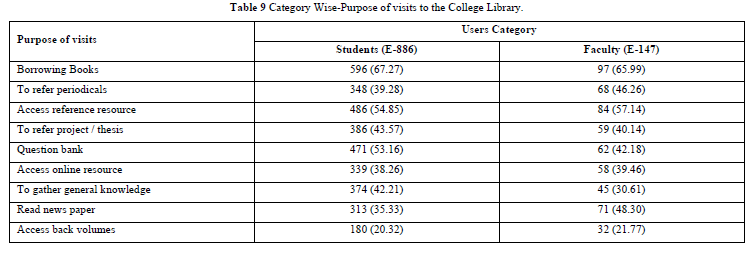
As shown in Table 9, the majority of both users-students, accounting for 67.27%, and faculty, accounting for 65.99% visited the college library for purpose of borrowing books. While the lowest proportions of both user categories faculty, accounting for 21.77%, and students accounting for 20.32% visited the library for purpose to access back volumes.
Preferred Sources for Obtain Information in the Library
Table 10 shows the type of source users prefers for obtain information in the Library. The Mean and standard deviation are calculated, and the preference of sources is ranked. Books are the most frequently preferred source for obtaining information, with 54.70% of users indicating it as their top choice.
Based on the responses Mean were calculated and ranked. Users gave first preference to source of Books as obtain information in the Library (4.16). Followed by Reference sources (4.01), Newspapers (3.87), E-resources/ e-database (3.82), Thesis / dissertations (3.73), Periodicals (3.68), Patent/ standard/maps (3.41) and Back volumes (3.37).
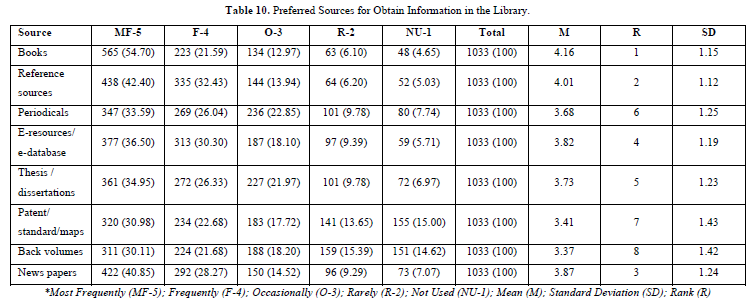
Categorized Wise-Preferred Sources for Obtain Information
The preference of sources for obtain information is analyzed based on the opinion of students and faculty users. Table 11 shows that more faculty users (4.31) prefer books for obtaining information compared to student users (4.13). Reference sources are given the second choice of preference by more faculty users (4.21) than student users (3.98). Newspapers are the third choice for faculty users (4.14), whereas students prefer E-resources/e-databases (3.83) as their third choice. Periodicals are the fourth choice for faculty users (3.97), whereas students prefer Newspapers (3.82) as their fourth choice. E-resources/ e-database are the fifth choice for faculty users (3.78), whereas students prefer Thesis / dissertations (3.75) as their fifth choice. Patents/ standards/ maps are the sixth choice for faculty users (3.72), whereas students prefer Periodicals (3.63) as their sixth choice. Thesis /dissertations are the seventh choice for faculty users (3.55), whereas students prefer Back volumes (3.42) as their seventh choice. The least preference is given to patents/standards/maps by student users (3.36), whereas faculty users prefer back volumes (3.10).
 Sources of Information Preferred for updating current affairs knowledge
Sources of Information Preferred for updating current affairs knowledge
Table 12 displays the types of information sources users prefer for updating current affairs knowledge. Newspapers are the most frequently preferred source, with 41.82% of users indicating it as their top choice Based on the responses, means were calculated and ranked. Among the five groups, users give first preference to newspapers (3.90) for updating current affairs knowledge. This is followed by E-resources/e-databases (3.83), current awareness services (3.81), journals/magazines (3.79), and conferences/ workshops (3.67).
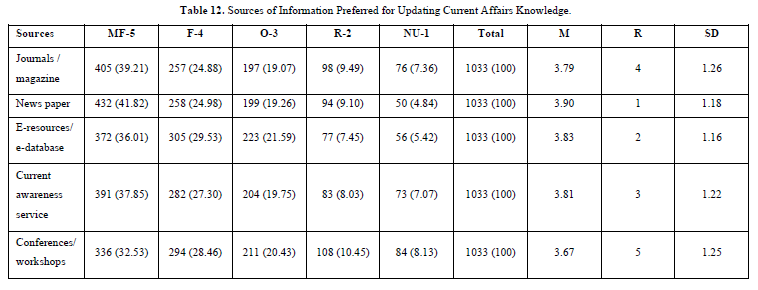
Categorized Wise-Sources of Information Preferred for updating current affairs knowledge
With regard to updating current affairs knowledge, the preferred sources among users are analyzed based on the opinions of both students and faculty. From Table 13, it is evident that faculty users (4.05) prefer Journals/ magazines as their first choice for updating current affairs knowledge, whereas student users (3.89) prefer newspapers as their first choice. Current awareness services are the second choice for faculty users (3.97), whereas students prefer E-resources/e-databases (3.84) as their second choice. Newspapers are the third choice for faculty users (3.96), while current awareness services are the third choice for students (3.78). E-resources/e-databases are the fourth choice for faculty users (3.78), while Journals/magazines are the fourth choice for students (3.75). The least preference is given to conferences/workshops by both students (3.69) and faculty (3.55) users.

User responses to the library offered services
Table 14 analyzes the users' opinion of library services offered by college libraries. From Table 14 it's evident that the majority of user’s rate the circulation services as excellent compared to all other services, respondents rated circulation at 53.53%.
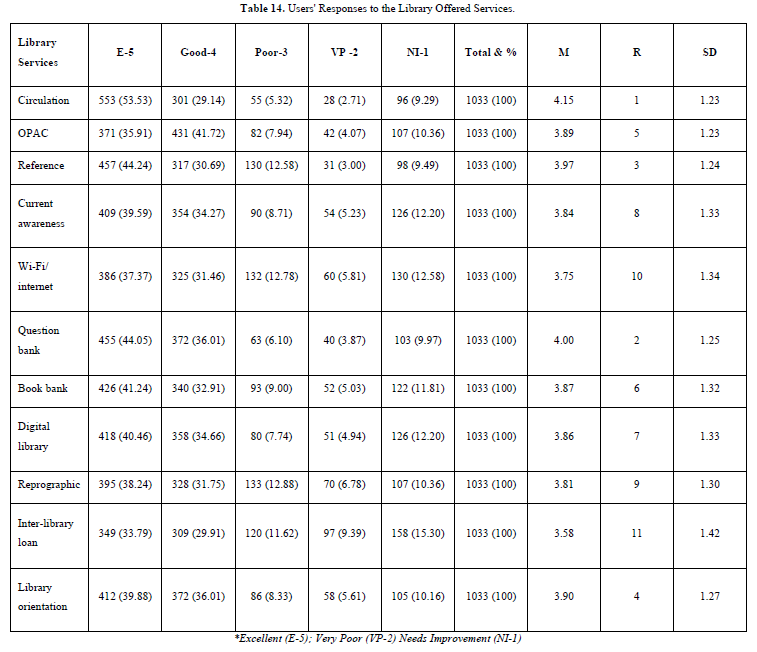
Based on the responses, means were calculated and services were ranked accordingly. Users ranked circulation services highest, with a mean response of (4.15) indicating it as their first choice. Following this were Question bank (4.00), Reference (3.97), Library orientation (3.90), OPAC (3.89), Book bank (3.87), Digital library (3.86), Current awareness (3.84), Reprographic (3.81), Wi-Fi/internet (3.75), and Inter-library loan (3.58).
Categorized Wise-Responses to the Library Offered Services
The responses of users to the library's offered services are analyzed based on the opinions of both student and faculty users. Table 15 indicates that circulation service is the most preferred service among all other services by both student and faculty users. Faculty users (4.27) show a slightly higher preference for circulation service compared to student users (4.13). Reference services emerge as the second choice for faculty users (4.18), while students prefer Question bank services (4.01) as their second choice. Reprographic services rank third among faculty users (4.06), whereas students prioritize Reference services (3.94) as their third choice. Digital library services rank fourth among faculty users (4.01), whereas students favor Book bank services (3.91) in this position. Question bank services are the fifth choice for faculty users (3.99), while students opt for Current awareness services (3.90) as their fifth choice. Both student and faculty users assign the least preference to Inter-library loan services, with student users rating it at 3.65 and faculty users at 3.14.
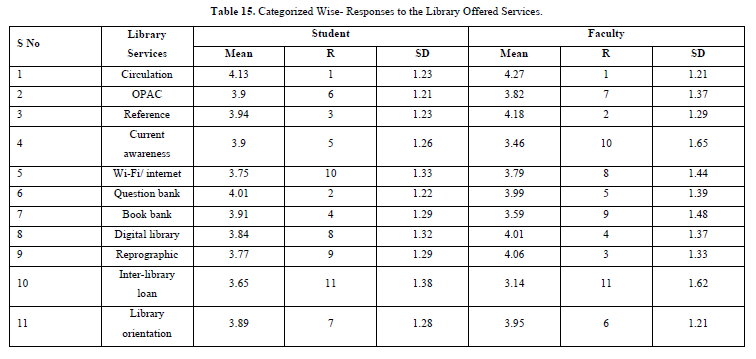 Ratings on the college library collection
Ratings on the college library collection
The ratings on the college library collection are analyzed based on users categorized as students (Table 16).

From Table 16 it is evident that the majority of users (51.50%) provided an excellent rating for the college library collection, followed by 31.17% rating it as good, and 10.55% expressing uncertainty. The least closely equal ratings were given to both poor (3.58%) and very poor (3.19%) for the college library collection by users.
Categorized Wise-Ratings on the College Library Collection
The ratings on the college library collection are analyzed based on the opinions of student and faculty users, as shown in Table 17. The table indicates that more faculty users (51.70%) provided an excellent rating on the college library collection compared to student users (51.47%). Additionally, more faculty users (34.01%) provided a good rating for the college library collection compared to student users (30.70%). The ratings for uncertain were nearly equal, with both student users (10.50%) and faculty users (10.88%) providing uncertain ratings for the college library collection. Furthermore, more student users (3.72%) provided a poor rating for the college library collection compared to faculty users (2.72%). Finally, the least number of student users (3.61%) provided a very poor rating for the college library collection compared to faculty users (0.68%).

FINDINGS
SUGGESTIONS
Users have suggested valuable improvements for relevant practices. One significant recommendation is to expand the comprehensive collection of books and resources to cater to diverse interests and educational needs. Another suggestion is to organize workshops to assist users in maximizing their utilization of library resources and enhancing their proficiency. Additionally, there is a need to improve library services, such as current awareness and interlibrary loans.
CONCLUSION
Numerous factors influence information needs, seeking behavior, and library services, making it essential to determine the substantial requirements of information users. The library's collection of resources plays a crucial role in achieving its goals and meeting the diverse needs of its users. This study revealed that users depend on the library to obtain information. Prefer to find information from books, reference books, newspapers and e-resources. Out of the services offered by the library, circulation services are utilized more while suggesting service lines such as interlibrary loan. Procuring effective and useful resources keeping in mind the demands and requirement of users will satisfy library’s users and increase their frequency of visits in library.
CONTRIBUTORS
Mr. Sachin P. Dhande is presently working as Librarian, at Dadasaheb Balpande College of Pharmacy, Nagpur, Maharashtra. I am currently a Ph D Scholars in the library & information department at Rashtrasant Tukadoji Maharaj Nagpur University Nagpur. I hold M. Phil and MLISc and qualified MH-SET. His contributions to the current study are data collection, analysis and writing.
Dr. Shashikant G. Rokade is working as Head at Department of Library, Sevadal Mahila Mahavidyalaya, Nagpur. His areas of interests are: Information systems, Open access, Metadata, Library Best Practices etc. His contribution to the current study is Developing the conceptual framework, preparing the draft of the paper, drafting questionnaire, writing-review & conclusion, editing and supervision.
No Files Found
Share Your Publication :